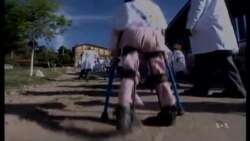Sixty years ago on April 12, Dr. Jonas Salk's polio vaccine was declared safe and effective. In just three years, the entire world could be polio free.
Polio is a life-changing disease that mostly affects young children. It's been around for thousands of years. In fact, ancient Egyptian carvings show young men with withered legs, but it wasn't until the 1900s that the number of cases began to increase in the U.S.
Oddly enough, it had to do with improved sanitation. Until then, children were repeatedly exposed to the polio virus, and that exposure gave them immunity. With better hygiene, children had less contact with the virus as infants, and polio began to spread.
By the 1940s, polio epidemics became common in the warm, summer months in the U.S. Each year, thousands of children and adults contracted this highly contagious virus. Most survived, about 1 percent were permanently crippled, others died.
An American president, Franklin D. Roosevelt, caught the virus before entering the White House. Under his leadership, the National Foundation for Infantile Paralysis, as polio was then known, asked Americans to donate a dime to fight polio. The foundation later became known as The March of Dimes.
With an infusion of money, researchers started working on a vaccine to prevent polio. Salk wanted to produce a vaccine containing a killed polio virus. Because the virus was dead, it could not cause disease, but it could trick the body into thinking it had been attacked and then produce antibodies against the disease. Its disadvantage was it might not provide long-term immunity.
At the same time, Dr. Albert Sabin tried making a vaccine with a live but much weaker polio virus.
On April 12, 1955, Salk announced that he had developed a polio vaccine that was ready for use. A few years later, Sabin's oral vaccine was ready.
Before a vaccine was widely available, the U.S. Centers for Disease Control and Prevention reported that the virus crippled more than 35,000 people in the U.S. each year. By 1979, polio had been eradicated in the U.S., but unless it was wiped out worldwide, it could come back.
A global effort to eradicate polio began in 1988, led by the World Health Organization, UNICEF and the Rotary Foundation. Since then, the WHO reports the number of polio cases has decreased by more than 99 percent, from an estimated 350,000 cases in 1988, to 416 reported cases in 2013.
Dr. John Sever has worked to eradicate polio through the Rotary Foundation since 1979. He told VOA, “We narrowed it down from being an infection and disease throughout the world to one that’s now only in three countries.”
Those three countries are Nigeria, Afghanistan and Pakistan. Oyewale Tomori said Nigeria has made a lot of progress. Tomori is president of the Nigerian Academy of Science. "Last year alone, we had only six cases," he said. "The year before, it was 53."
Nigeria has had no cases of polio for at least eight months. But Tomori noted that it is not easy to get children vaccinated in parts of the country experiencing conflict.
That's largely why polio still exists in Afghanistan and Pakistan as well. Conflicts in these countries present a real challenge to the international goal of eradicating polio by 2018.
As Sever said, "The idea is that you have to eradicate it everywhere, or it can continue to live in people and be transmitted to nonimmunized people."





